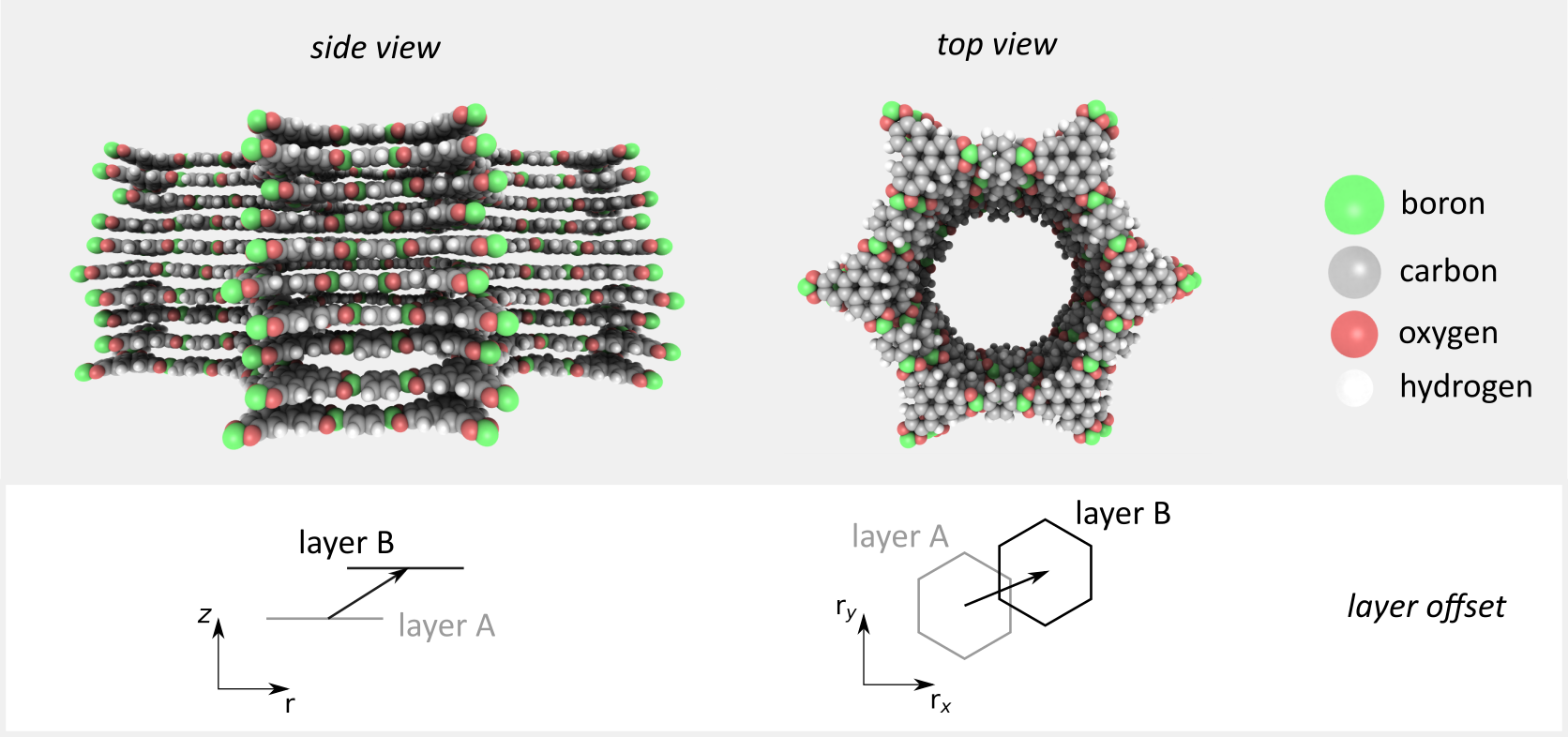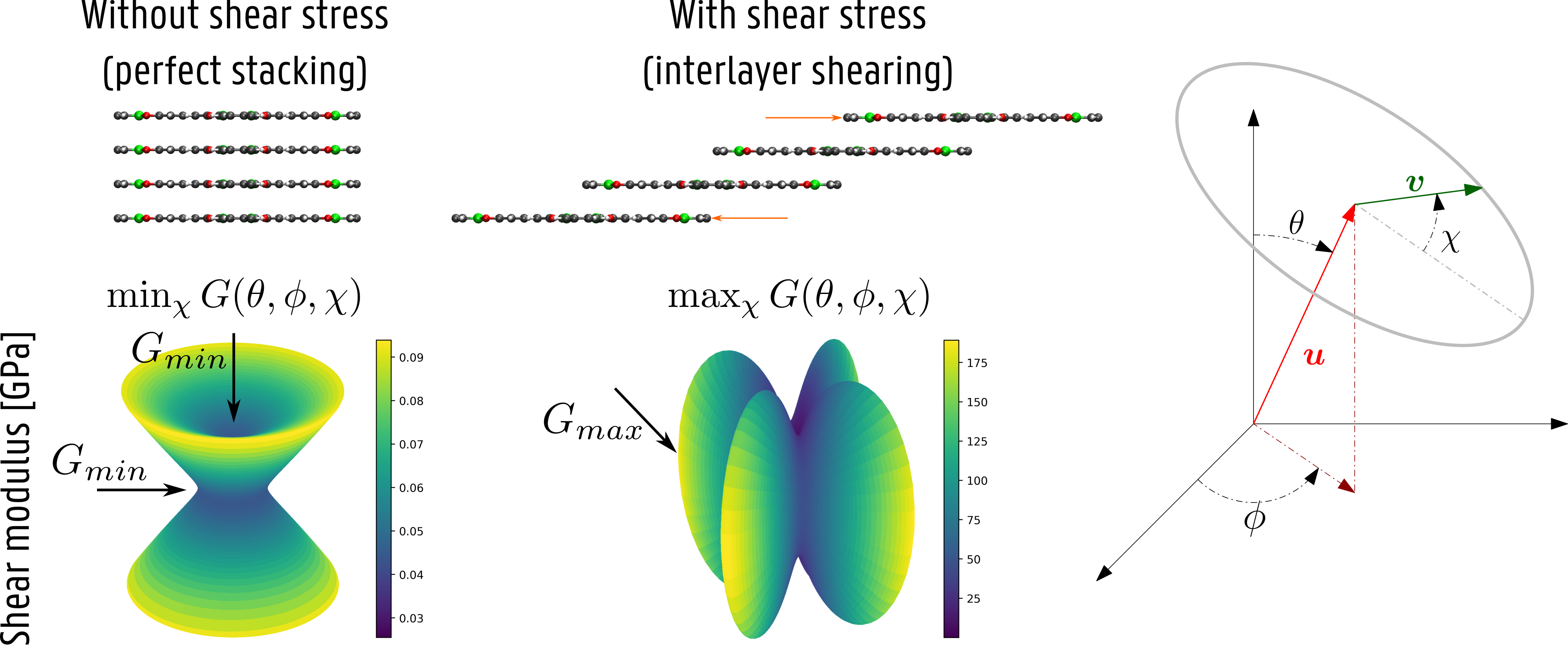Are 2D COFs the new graphite: Increasing the stability of layered structures through the implementation of a constant stress ensemble
Are 2D COFs the new graphite: Increasing the stability of layered structures through the implementation of a constant stress ensemble
Promotor(en): V. Van Speybroeck /28114 / Model and software developmentBackground and problem
2D materials often boast exceptional properties that are only seldomly found in more common 3D materials. Examples are the high thermal and electrical conductivity of graphene and graphite. In addition, 2D materials can adopt a variety of structures, such as graphene nanotubes. These attractive properties arise from their specific layered structure and resulting delocalized electrons. While graphene and graphite are textbook and extensively studied 2D materials, they only contain carbon atoms which limits their applicability. A much richer versatility in solid-state 2D materials can be found in covalent organic frameworks (COFs), as these layered structures mainly consist, besides carbon, out of hydrogen, nitrogen, and oxygen (see Figure 1).1 In addition, COFs are highly porous, which opens opportunities for gas adsorption, gas separation, polymorphism, and catalysis. However, as a recently discovered class of materials, little is known about the structure and properties of (2D) COFs. As a result, their usage in practical devices remains limited, although they could in theory greatly surpass the applicability of purely carbon-based structures.

Figure 1: Example structure of a 2D covalent organic framework (COF), demonstrating its layered structure and porosity. For flat layers such as here, layer slipping occurs very easily, resulting in a large layer offset and a reduction of the mechanical stability of the material.
To obtain insight into the structure of solid-state materials such as COFs, molecular modeling is an essential tool. It allows us to uniquely correlate the atomic structure of these materials with their macroscopic behavior, such as conductivity or polymorphism. However, 2D materials are notoriously difficult to model, given their strongly anisotropic response to external stimuli such as temperature or pressure changes. For instance, Figure 2 illustrates the response of a 2D COF under the application of a shear stress (indicated by orange arrows). The resistance of this material to withstand these shear stresses, which is defined by its shear modulus, is highly direction dependent, as shown in Figure 2. In practical terms: it is much easier to move adjacent layers on top of each other, rather than try to compress these layers together. However, up to now, we do not have the appropriate general tools to describe the response of such materials to anisotropic stresses at experimental conditions. As a result, it remains impossible at this point to fully control the layer slipping behavior in 2D COFs, limiting the engineering potential for specific applications.

Figure 2: Upon an anisotropic shear stress (indicated with the orange arrows), 2D materials show a strongly anisotropic response. The bottom figures show the maximum and minimum shear moduli of a 2D COF, which quantifies its resistance to an anisotropic shear stress.
Goal
In this thesis, our intention is to understand the response of a variety of 2D COFs to an anisotropic stress, building on our earlier success in describing the equilibrium structure of these materials.2 A first task in this thesis will be to develop and implement ensembles that can mimic anisotropic stress conditions, starting from our in-house Yaff software package.3,4 This is a challenging task, as it requires combining knowledge of thermodynamics and statistical physics to ensure the simulated response of a 2D material closely follows the experimentally observed response. Of course, the student will be actively coached to make him/her acquainted with the advanced simulation techniques early in the thesis year, and to transfer necessary programming skills needed to perform the research. In addition, interactions with experimental collaborators will help to validate the obtained results.
In the second task, the implementation of the first task will be put to a further test to identify how the building blocks in 2D COFs can be chosen with the aim to increase its resistance against shear deformation (increase the minimal shear modulus of Figure 2).1 Several potential pathways have been proposed in literature, such as the inclusion of extended building blocks, building blocks with bulky substituents or multiple aromatic moieties, or building blocks containing atoms with large differences in electronegativity.5 However, due to the absence of a reliable constant-stress simulation protocol, these pathways have not yet been verified theoretically. In this part of the thesis, it is our aim to address this shortcoming and understand how these pathways alter the atomic interactions and anisotropic mechanical properties of a variety of 2D COFs. As a result, comprehensible design rules can be defined to promote the stability of 2D COFs and open the avenue for their widespread use in materials science.
- Study programmeMaster of Science in Engineering Physics [EMPHYS], Master of Science in Physics and Astronomy [CMFYST]KeywordsLayered structures, 2D materials, thermodynamic ensemble, Covalent organic frameworks, anisotropic stress, mechanical stabilityReferences
1S.B. Alahakoon, S.D. Diwakara, C.M. Thompson, R.A. Smaldone, Chem. Soc. Rev. 49: 1344, 2020.
2S. Borgmans, S.M.J. Rogge, J.S. De Vos, C.V. Stevens, P. Van Der Voort, V. Van Speybroeck, Angew. Chem. Int. Ed. 60: 8913, 2021.
3M. Parrinello, A. Rahman, J. Appl. Phys. 52: 7182, 1981.
4R.E. Miller, E.B. Tadmor, J.S. Gibson, N. Bernstein, F. Pavia, J. Chem. Phys. 144: 184107, 2016.
5L. Ascherl, T. Sick, J.T. Margraf, S.H. Lapidus, M. Calik, C. Hettstedt, K. Karaghiosoff, M. Döblinger, T. Clark, K.W. Chapman, F. Auras, T. Bein, Nat. Chem. 8: 310, 2016.
